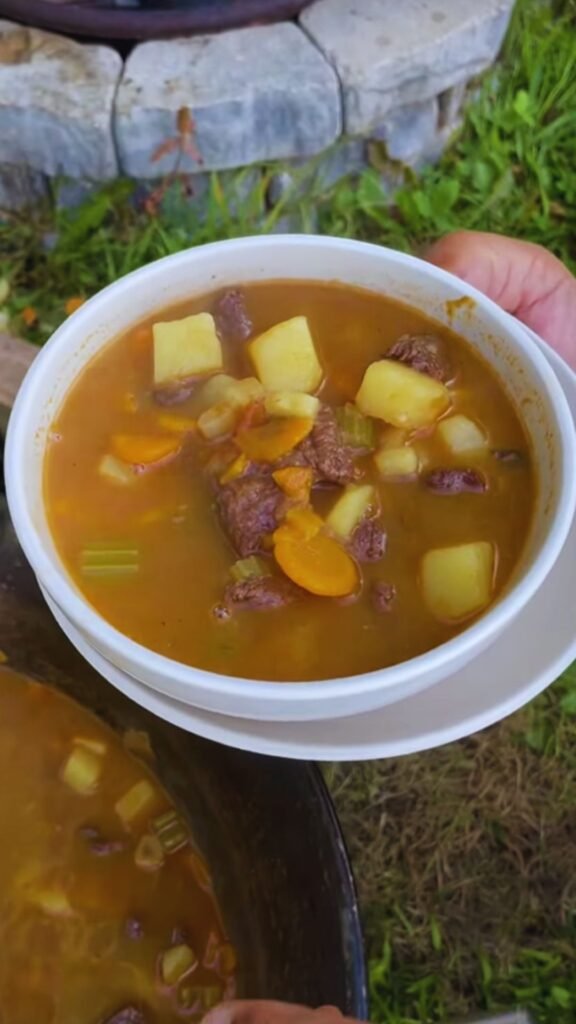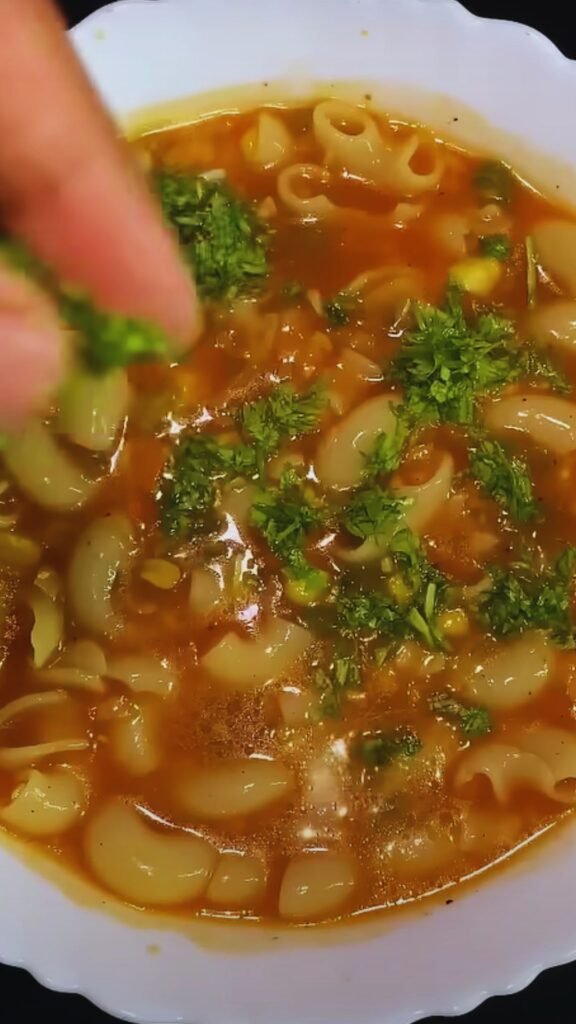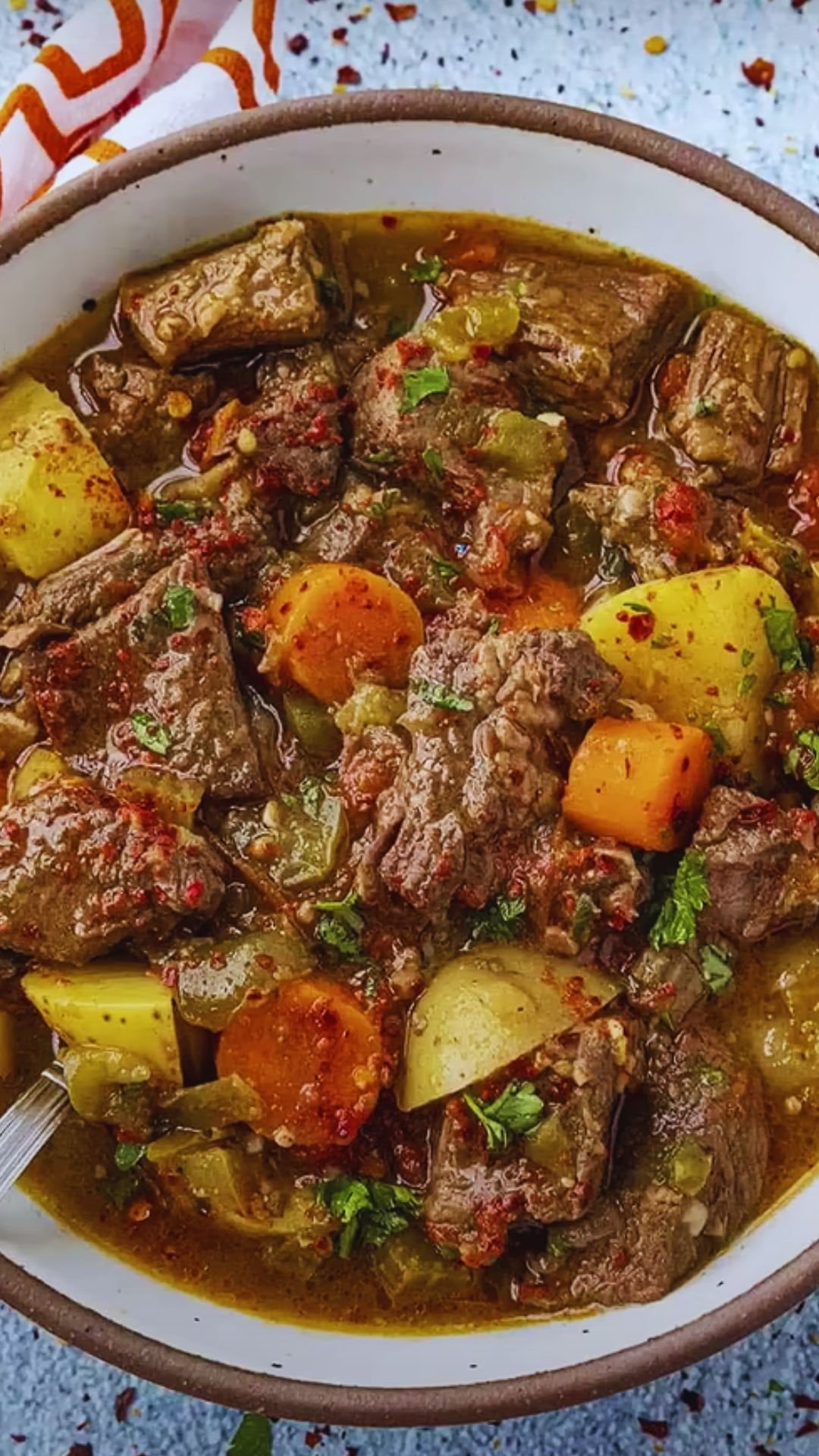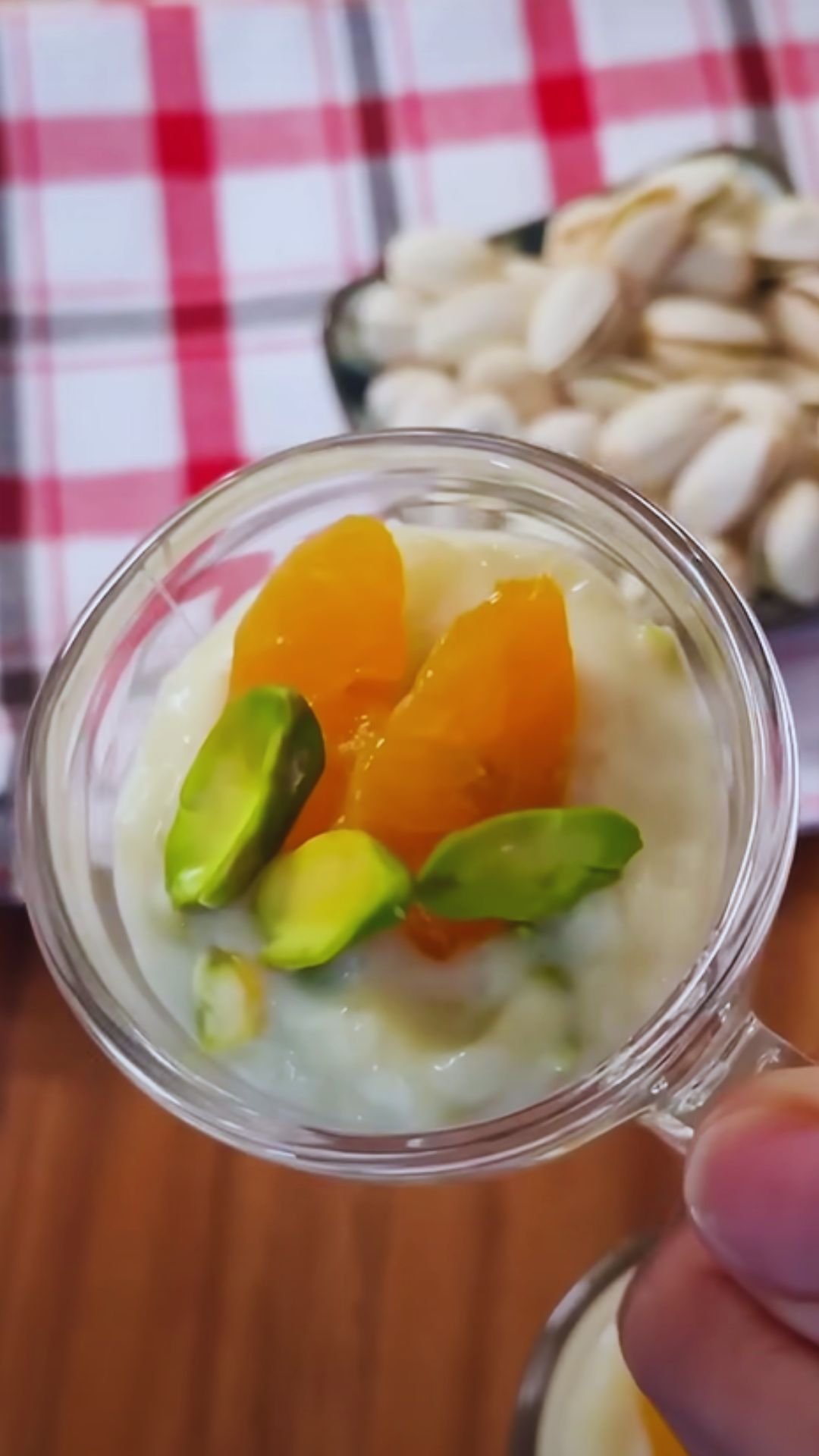There’s something magical about a steaming bowl of goulash soup that transports me back to my grandmother’s kitchen. That rich tomato broth, tender beef chunks, and perfectly cooked macaroni create a symphony of flavors that’s both nostalgic and deeply satisfying. Today, I’m sharing my perfected recipe for this classic comfort food that has graced my family table for generations.
This isn’t just any soup—it’s a complete meal in a bowl that combines the heartiness of beef stew with the comfort of pasta in a rich tomato base. Whether you call it goulash soup, beef and tomato macaroni soup, or simply “that amazing red soup with pasta,” I promise this recipe will become a staple in your home cooking repertoire.
What Makes This Goulash Soup Special
Before we dive into the recipe, let me tell you why this particular version stands out. I’ve spent years perfecting this dish, finding the perfect balance of spices, the ideal beef-to-pasta ratio, and the exact cooking times to ensure tender meat and perfectly al dente pasta.
My goulash soup features:
- Tender chunks of beef simmered to perfection
- A rich tomato broth with layers of flavor
- The perfect blend of Hungarian paprika and warming spices
- Hearty vegetables that complement rather than overwhelm
- Elbow macaroni cooked directly in the broth for maximum flavor absorption
This isn’t the thin, watery soup you might find in some cafeterias. This is a robust, stick-to-your-ribs meal that satisfies even the heartiest appetites.
The History Behind the Bowl
Goulash has fascinating roots in Hungarian cuisine, where it began as a simple shepherd’s stew. Traditional Hungarian gulyás (pronounced “goo-yash”) was made by cattle herders who would dry meats and vegetables, then reconstitute them in a portable pot over an open fire when it was time to eat.
The version we enjoy today has evolved considerably, especially as it traveled across Eastern Europe and eventually to American kitchens. The addition of macaroni is an American adaptation that transforms the dish into something uniquely comforting and familiar to those of us who grew up with pasta-based comfort foods.
What I love about this recipe is how it honors those Hungarian roots through the use of paprika and caraway seeds while incorporating elements that make it accessible and appealing to modern palates.
Essential Ingredients for Perfect Goulash Soup

Before we start cooking, let’s gather everything we need. The beauty of this recipe lies in its straightforward ingredients—most of which you probably already have in your pantry.
For the Soup Base:
- 2 tablespoons olive oil
- 2 tablespoons butter
- 1 large yellow onion, finely diced
- 2 medium carrots, diced into small cubes
- 2 stalks celery, finely chopped
- 4 cloves garlic, minced
- 2 tablespoons tomato paste
- 2 tablespoons Hungarian sweet paprika (authentic if possible)
- 1 teaspoon smoked paprika
- 1 teaspoon caraway seeds
- 1/2 teaspoon dried marjoram
- 1/4 teaspoon cayenne pepper (adjust to taste)
- 2 bay leaves
The Main Components:
- 1.5 pounds beef chuck, cut into 1/2-inch cubes
- 1 can (28 oz) crushed tomatoes
- 2 tablespoons Worcestershire sauce
- 6 cups beef broth (homemade preferred, but quality store-bought works)
- 1 green bell pepper, diced
- 1 red bell pepper, diced
- 8 ounces elbow macaroni (about 2 cups)
- Salt and freshly ground black pepper to taste
For Garnish:
- Fresh parsley, chopped
- Sour cream
- Grated sharp cheddar cheese (optional)
Ingredient Notes:
Hungarian paprika: This is the heart and soul of goulash. If possible, invest in authentic Hungarian sweet paprika—it has a depth of flavor that regular paprika simply can’t match. The difference is truly remarkable.
Beef chuck: This cut has the perfect balance of meat and fat for slow simmering. The connective tissue breaks down during cooking, creating tender morsels of beef while adding richness to the broth.
Caraway seeds: Don’t skip these! They add an authentic flavor that’s subtle but important. I crush mine lightly before adding to release more flavor.
Equipment You’ll Need
One of the things I love about this recipe is that it’s a one-pot wonder. You’ll need:
- Large Dutch oven or heavy-bottomed soup pot (6-quart capacity or larger)
- Sharp chef’s knife for cutting meat and vegetables
- Wooden spoon for stirring
- Measuring cups and spoons
Step-by-Step Cooking Method
Step 1: Prepare the Beef
Season the beef cubes generously with salt and pepper. Heat 1 tablespoon of olive oil in your Dutch oven over medium-high heat. Working in batches (don’t overcrowd!), brown the beef on all sides, about 3-4 minutes per batch. Transfer the browned beef to a plate and set aside.
Pro tip: Don’t rush this step! Proper browning creates the foundational flavor for your soup. Those browned bits stuck to the bottom of the pot? That’s pure gold for flavor development.
Step 2: Build the Flavor Base
In the same pot, add the butter and remaining tablespoon of olive oil. Once melted, add the diced onions, carrots, and celery. Cook over medium heat for 5-7 minutes until the vegetables soften and the onions become translucent.
Add the minced garlic and cook for another 30 seconds until fragrant. Stir in the tomato paste and cook for 2 minutes, allowing it to caramelize slightly.
Step 3: Incorporate the Spices
This is where the magic happens! Add both paprikas, caraway seeds, marjoram, and cayenne pepper to the pot. Stir continuously for about 1 minute to toast the spices, being careful not to burn them. The aroma at this point will be absolutely intoxicating.
Step 4: Create the Soup Base
Return the browned beef to the pot along with any accumulated juices. Add the crushed tomatoes, Worcestershire sauce, bay leaves, and beef broth. Stir to combine and bring to a gentle boil.
Reduce heat to low, cover partially, and simmer for 1 hour to 1 hour 15 minutes, or until the beef is tender when pierced with a fork.
Step 5: Add Peppers and Pasta
Once the beef is tender, add the diced bell peppers and elbow macaroni to the pot. Increase heat to maintain a gentle simmer and cook uncovered for 8-10 minutes, or until the pasta is al dente.
Important note: The pasta will continue to absorb liquid as the soup sits. If you’re not serving immediately, consider undercooking the pasta slightly or cooking it separately and adding to individual servings.
Step 6: Final Touches
Remove the bay leaves. Taste and adjust seasonings with additional salt and pepper as needed. If the soup is too thick, add a bit more broth to reach your desired consistency.
Let the soup rest off the heat for about 5 minutes before serving. This short rest allows the flavors to meld and settle.
Serving Suggestions

Ladle the hot soup into bowls and garnish with a dollop of sour cream, a sprinkle of fresh parsley, and a handful of grated cheddar cheese if desired. The contrast of the cool, tangy sour cream against the hot, rich soup creates a magnificent flavor experience.
I like to serve my goulash soup with:
- Crusty artisan bread or garlic bread for dipping
- A simple green salad with vinaigrette for freshness
- Quick-pickled cucumbers for a tangy contrast
- A sprinkle of additional paprika on top for color and flavor
For a complete Hungarian-inspired meal, consider serving with traditional cucumber salad (uborkasaláta) on the side.
Storage and Reheating Instructions
Refrigerator Storage:
This soup actually tastes even better the next day! Allow it to cool completely, then transfer to airtight containers and refrigerate for up to 4 days.
Freezer Instructions:
For freezing, I recommend doing so before adding the pasta. Freeze the base soup in freezer-safe containers for up to 3 months. When ready to eat, thaw overnight in the refrigerator, reheat, and add freshly cooked pasta.
If you’ve already added pasta and want to freeze leftover soup, be aware that the texture of the pasta will change slightly upon thawing and reheating.
Reheating Tips:
Reheat on the stovetop over medium-low heat, stirring occasionally. You may need to add a splash of broth or water as the pasta will have absorbed liquid during storage.
Nutritional Information
For those who are tracking their nutritional intake, here’s a breakdown of what you can expect per serving (approximately 1.5 cups):
| Nutrient | Amount |
|---|---|
| Calories | 385 |
| Protein | 28g |
| Carbohydrates | 32g |
| Dietary Fiber | 4g |
| Sugars | 6g |
| Fat | 16g |
| Saturated Fat | 6g |
| Cholesterol | 75mg |
| Sodium | 820mg |
| Potassium | 745mg |
| Iron | 4mg |
| Calcium | 70mg |
| Vitamin A | 3500 IU |
| Vitamin C | 45mg |
Note: These values are approximate and may vary based on specific ingredients used.
Recipe Variations and Adaptations
One of the beautiful aspects of goulash soup is its versatility. Here are some variations you might enjoy:
Spicy Goulash:
Double the cayenne pepper and add a diced jalapeño with the bell peppers for a soup with significant heat.
Vegetable-Forward Version:
Add 1 cup of diced parsnips and 2 cups of mushrooms for an earthier flavor profile with even more vegetable goodness.
Slow Cooker Adaptation:
After browning the meat and sautéing the vegetables, transfer everything to a slow cooker. Cook on low for 6-7 hours, adding the pasta during the last 30 minutes.
Instant Pot Method:
Use the sauté function for the initial steps, then pressure cook for 25 minutes with natural release. Add the pasta afterward using the sauté function again until cooked.
Vegetarian Option:
Replace the beef with 2 pounds of mixed mushrooms (portobello, cremini, and shiitake work well) and use vegetable broth instead of beef broth. Add 1 tablespoon of soy sauce for depth of flavor.
Seasonal Adaptations
| Season | Adaptation |
|---|---|
| Summer | Add 2 cups of fresh diced zucchini and sweet corn kernels when adding the bell peppers. Garnish with fresh basil instead of parsley. |
| Fall | Add 1 cup of diced butternut squash and substitute 1/2 teaspoon of cinnamon for the marjoram. |
| Winter | Increase beef to 2 pounds and add 1/2 cup of peeled, diced parsnips with the carrots for a heartier version. |
| Spring | Add 1 cup of fresh or frozen peas during the last 5 minutes of cooking and garnish with fresh dill. |
Common Pitfalls and How to Avoid Them
Tough Beef:
Problem: Beef remains tough even after long cooking. Solution: Cut the beef into smaller, even pieces and ensure you’re simmering gently, not boiling. Consider extending the cooking time by 15-30 minutes if needed.
Mushy Pasta:
Problem: Pasta becomes too soft and loses its texture. Solution: Add the pasta later in the cooking process or cook it separately and add to individual servings if you plan to have leftovers.
Bland Flavor:
Problem: The soup lacks depth of flavor. Solution: Don’t skip the browning step for the beef, make sure to properly toast the spices, and consider adding a beef bouillon cube for extra richness if needed.
Too Thick/Too Thin:
Problem: The soup’s consistency isn’t right. Solution: For a thinner soup, add more broth. For a thicker soup, create a slurry with 1 tablespoon each of cornstarch and cold water, then stir into the simmering soup.
The Perfect Bite

The perfect spoonful of goulash soup should contain a little bit of everything—tender beef, al dente pasta, softened vegetables, and that rich, paprika-infused broth. I like to stir my soup just before eating to ensure every bite has this perfect composition.
For an extra touch of luxury, try floating a small piece of butter on top of your hot soup just before serving. As it melts, it creates a beautiful richness that elevates the entire dish.
Questions & Answers
Q: Can I use ground beef instead of beef chunks?
Yes, absolutely! Ground beef creates a different but equally delicious version sometimes called “American goulash.” Brown the ground beef at the beginning, drain excess fat, and continue with the recipe as written. The cooking time for the beef will be significantly reduced—simply simmer for about 20 minutes before adding the pasta.
Q: Is there a way to make this recipe less acidic?
If you find tomato-based soups too acidic, add 1/2 teaspoon of baking soda to the soup after adding the tomatoes. It will foam slightly; stir until the reaction stops. You can also add 1-2 teaspoons of sugar to balance the acidity.
Q: Can I make this soup in advance for a dinner party?
This soup is perfect for make-ahead meals! I recommend preparing everything except the pasta up to two days in advance. Reheat the soup to a simmer, then add the pasta and cook until tender before serving. This ensures the pasta maintains its perfect texture.
Q: What if I don’t have Hungarian paprika?
Regular sweet paprika will work, though the flavor won’t be quite as complex. Try adding a teaspoon of tomato paste and a pinch more caraway seeds to compensate for the flavor difference.
Q: How can I thicken the soup if it’s too watery?
Create a slurry by mixing 2 tablespoons of cornstarch with 2 tablespoons of cold water. Stir this mixture into the simmering soup and cook for an additional 5 minutes. Alternatively, remove 1 cup of soup (avoiding meat pieces), blend it, and stir it back into the pot.
Q: Is this recipe freezer-friendly?
Yes, but for best results, freeze it before adding the pasta. The base soup freezes beautifully for up to 3 months. When ready to serve, thaw overnight in the refrigerator, reheat to a simmer, and add fresh pasta.
Q: Can I substitute the beef with another protein?
Absolutely! Boneless chicken thighs (cut into chunks) work wonderfully with a reduced cooking time of about 30 minutes. For pork, shoulder or country-style ribs cut into cubes are excellent alternatives with a similar cooking time to beef.
Q: How can I make this more budget-friendly?
Look for beef chuck or stew meat when it’s on sale and freeze it for later use. You can also reduce the amount of meat and increase the vegetables. Adding an extra cup of beans (kidney or pinto work well) will add protein and stretch the soup further without compromising flavor.
My Personal Touch
What makes this recipe special to me is the blend of traditions it represents. My Hungarian grandmother taught me the importance of good paprika and patient cooking, while my mother added the American touch of elbow macaroni. I’ve further refined it over the years, learning that a splash of Worcestershire sauce adds depth that complements the paprika perfectly.
I believe food should tell a story and create memories. This goulash soup has accompanied my family through cold winter evenings, comforted sick children, and welcomed new neighbors. It’s more than a recipe—it’s a tradition in a bowl, ready to become part of your family’s story too.
Whether you’re an experienced cook or just starting your culinary journey, this goulash soup recipe is forgiving and rewarding. The steps might seem numerous, but each one builds flavor that results in a truly memorable meal. I hope it brings as much comfort and joy to your table as it has to mine over the years.
Happy cooking!
Your Questions Answered
Q: What’s the difference between Hungarian goulash and American goulash?
Traditional Hungarian goulash is more of a soup or stew heavily seasoned with paprika, featuring chunks of beef and potatoes. American goulash typically includes elbow macaroni and ground beef in a tomato-based sauce, making it more of a pasta dish. This recipe bridges the two styles by using the chunked beef and paprika of Hungarian goulash with the macaroni component of American goulash.
Q: How spicy is this soup?
As written, this soup has a mild to medium heat level. The cayenne pepper adds a gentle warmth rather than significant spice. You can easily adjust this by omitting the cayenne entirely for a mild version or doubling it for more heat.
Q: Can I use a different pasta shape?
Absolutely! While elbow macaroni is traditional, any small pasta shape works well. Small shells, ditalini, or even broken spaghetti are excellent alternatives. Just adjust the cooking time according to the pasta package directions.
Q: What’s the best beef cut to use for this soup?
Beef chuck is my top recommendation because it becomes tender and flavorful when simmered. Other good options include beef stew meat, bottom round, or even short ribs if you want something more luxurious. Avoid using lean cuts like tenderloin or sirloin as they’ll become tough with extended cooking.
Q: How do I know when the beef is tender enough?
The beef should easily yield when pierced with a fork. If there’s resistance, continue cooking in 15-minute increments until tender. The exact time will vary based on the specific cut and the size of your beef cubes.
Q: Is there a good substitute for Worcestershire sauce?
If you don’t have Worcestershire sauce, you can substitute with a mixture of 2 teaspoons soy sauce, 1/4 teaspoon lemon juice, a dash of hot sauce, and a pinch of brown sugar. Alternatively, soy sauce alone or a splash of balsamic vinegar can provide a similar umami depth.
Q: How do I store leftovers, and how long will they keep?
Cool the soup completely before transferring to airtight containers. Refrigerated leftovers will keep for 3-4 days. The pasta will continue to absorb liquid as it sits, so you may need to add a splash of broth when reheating. For longer storage, freeze for up to 3 months, ideally before adding pasta.
Q: Can I make this in a slow cooker or Instant Pot?
Yes! For slow cooker: Brown the meat and sauté vegetables as directed, then transfer to a slow cooker with remaining ingredients except pasta. Cook on low for 6-7 hours, add pasta, and cook 30 minutes more. For Instant Pot: Use sauté function for initial steps, pressure cook on high for 25 minutes with natural release, then add pasta using sauté function until tender.


